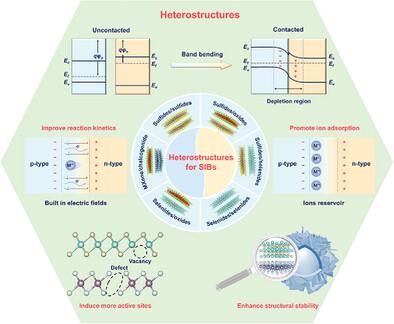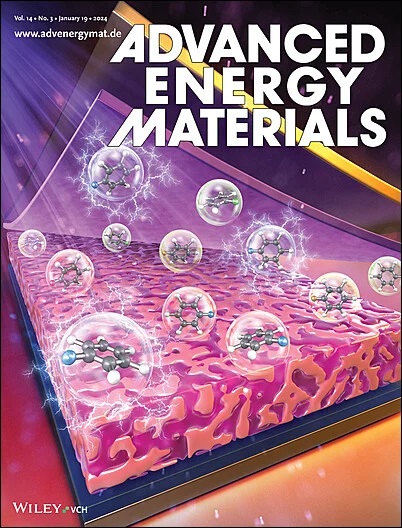先进钠离子电池中金属硫族化合物异质结构的界面工程
IF 24.4
1区 材料科学
Q1 CHEMISTRY, PHYSICAL
引用次数: 0
摘要
钠离子电池(SIBs)已成为大规模储能应用中最有前途的候选材料之一。基于合金化或转化反应的金属硫族化物负极材料因其理论容量高、氧化还原反应丰富而受到广泛研究。然而,它们固有的局限性,如高电压滞后和大体积膨胀阻碍了它们的进一步应用。异质结构的构建已成为缓解上述问题的一种有吸引力的策略。异质界面处的内建电场(BIEFs)的形成将加速Na+和电子的迁移。此外,异质结构还可以提高结构稳定性,产生更多的活性位点并提供额外的容量。值得注意的是,异质界面性质对异质结构的整体电化学性能起着重要的促进作用。然而,目前缺乏对其界面工程的系统理解。本文综述了近年来金属硫族化合物异质结构阳极材料的研究进展。首先介绍了异质结构的定义、分类和作用。其次,详细讨论了金属硫族化物异质结构sib阳极的研究进展。最后,对异质结构电池的未来发展前景和潜在的研究方向进行了展望。本文章由计算机程序翻译,如有差异,请以英文原文为准。

Interfacial Engineering of Metal Chalcogenides-based Heterostructures for Advanced Sodium-Ion Batteries
Sodium-ion batteries (SIBs) have become one of the most promising candidates for large-scale energy storage applications. Metal chalcogenides anode materials based on alloying or conversion reactions are widely studied because of their high theoretical capacities and rich redox reactions. However, their intrinsic limitations such as high voltage hysteresis and large volume expansion hinder their further applications. The construction of heterostructures has become an attractive strategy to alleviate the above issues. The formation of built in electric fields (BIEFs) at the heterointerfaces will accelerate the migration of Na+ and electrons. Moreover, heterostructures can also enhance the structural stability, generate more active sites and provide additional capacity. It is worth noting that heterointerfacial properties play a significant role in promoting the overall electrochemical performance of the heterostructures. However, a systematic understanding of their interfacial engineering is currently lacking. This article reviews the research progress of metal chalcogenides-based heterostructure anode materials in the near term. First, the definition, classification and the roles of heterostructures are introduced. Second, the detailed research progress of the metal chalcogenide-based heterostructures anodes in SIBs is discussed. Finally, the future prospects and potential research directions of the heterostructures for batteries are discussed.
求助全文
通过发布文献求助,成功后即可免费获取论文全文。
去求助
来源期刊

Advanced Energy Materials
CHEMISTRY, PHYSICAL-ENERGY & FUELS
CiteScore
41.90
自引率
4.00%
发文量
889
审稿时长
1.4 months
期刊介绍:
Established in 2011, Advanced Energy Materials is an international, interdisciplinary, English-language journal that focuses on materials used in energy harvesting, conversion, and storage. It is regarded as a top-quality journal alongside Advanced Materials, Advanced Functional Materials, and Small.
With a 2022 Impact Factor of 27.8, Advanced Energy Materials is considered a prime source for the best energy-related research. The journal covers a wide range of topics in energy-related research, including organic and inorganic photovoltaics, batteries and supercapacitors, fuel cells, hydrogen generation and storage, thermoelectrics, water splitting and photocatalysis, solar fuels and thermosolar power, magnetocalorics, and piezoelectronics.
The readership of Advanced Energy Materials includes materials scientists, chemists, physicists, and engineers in both academia and industry. The journal is indexed in various databases and collections, such as Advanced Technologies & Aerospace Database, FIZ Karlsruhe, INSPEC (IET), Science Citation Index Expanded, Technology Collection, and Web of Science, among others.
 求助内容:
求助内容: 应助结果提醒方式:
应助结果提醒方式:


